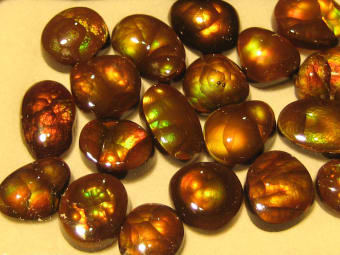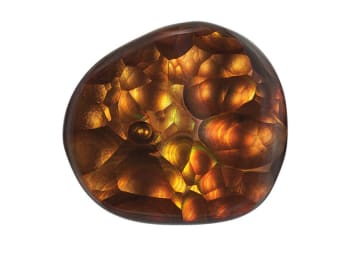Flexible Payments
Get 25% off your on cart total of $500 or more
The title picture for this article is one of the best illustrations of fire agate we have seen. It is a custom-made Fire Agate Ring by Master Cutter, Richard Krukowski Fire Agate Art Studio, and the photograph is his too.
Now "agate" is the term used to describe the banded form of chalcedony, however, fire agate is not banded nor does it display any fire in the rough. It is typically an unprepossessing rock similar to the rough shown below in another picture from Ryszard Krukowski. That is one reason it was not documented as a gemstone until the early 1940s. It took cutters a long time to learn how to cut the stone and maximize its iridescence potential. The ring illustrated in the title picture shows just how well a master like Ryszard can work with this material.

Mineralogist Joel Arem describes fire agate as chalcedony layered with platy crystals of iron oxide resulting in iridescence brought out by cutting and polishing. Ryszard Krukowski's ring, is an example of how beautiful fire agate can be after a skilled cutter follows the contours and layering of the stone using a variety of diamond dental sanding disks, drills and wheels. Even when looking at the commercial to low quality range, as illustrated by the Author Renee Newman below when she photographed examples at a gem show, this stone surprises and delights. Fire agate has a predominantly brown color with varying amounts of colorful iridescence within caused by thin film interference.

Fire agate is found in Arizona in the U.S. as well as the states of Aguascalientes, Chihuahua, Jalisco and San Luis Potosi in Mexico. It has also been found in California and New Mexico.
The two main mining locations for fire agate in Arizona are Deer Creek, located in the Galiuro Mountains and Slaughter Mountain, located near Globe on the San Carlos Indian Reservation; the latter is also famous for its peridot. The mining areas are about 100 miles apart from each other in southeastern Arizona, and each mine produces stones with very distinct characteristics.
Fire agate is harder and wears better than other stones with optical effects such as opal and ammolite. The GIA Gem Reference Guide, says that it is usually safe to clean chalcedony with ultrasonics and steamers, but warns that it is attacked by hydrofluoric acid, which jewelers might use, but is unlikely to be used in a domestic setting.
From an expert's perspective, Krukowski, who has had more than 40 years’ experience cutting, setting and selling fire agate and he has not experienced any problems with it scuffing, cracking or abrading with normal wear and tear. However, he does not recommend firing stones with metal casting/sculpting clay because the extreme heat would crack the fire agate. While Krukowski has successfully re-sized a ring set with fire agate by wrapping the stone in wet paper/cloth to keep it cool, it is probably advisable for less experienced jewelers to remove fire agate before sizing rings.
Even though fire agate is a very durable stone, like any other gemstone, it’s best to avoid hard wear and sharp blows in order to maintain the beauty of your fire agate jewelry.
Fire agate was formed as the result of volcanic activity that occurred millions of years ago. Due to extreme volcanic activity in some areas, hot water with silica and iron oxide seeped into cracks and cavities of certain rocks below the Earth’s surface. Layers of chalcedony with crystals of iron oxide formed as the solution cooled. A unique mix of ingredients with the right temperatures and temperatures allowed the agate to cool in bubbly, grape-like formations that are described as "botryoidal" by mineralogists. The brown areas of the chalcedony are caused by the iron oxide.

Fire agate is one of the easiest stones to identify because of its unique bubbly brown appearance and distinctive iridescent colors. It is unlikely to be confused with anything apart from, perhaps, fire opal in matrix. It is generally translucent to semi-opaque and has the same gemological properties as other chalcedonies:
Refractive Index: 1.53–1.54
Specific gravity: 2.55– 2.69
Hardness: 6.5–7.0
Cleavage: none
Pleochroism: none
Fire agate is generally an affordable gem, but in extra fine qualities, large stones and carvings can cost several thousand dollars. The gems may be priced either by the carat or the piece. Small low-grade stones with hardly any iridescence may sell for less than $20 each. Prices vary widely depending on the seller and the following factors:


